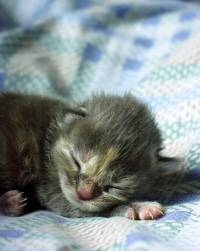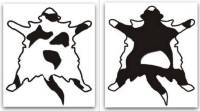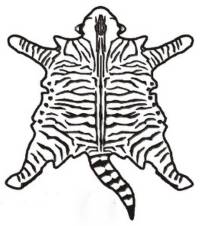The Colors of the Maine Coon
Colorpoint, which is most closely associated with the Siamese cat, like the modifier-induced black varieties "amber", "chocolate", "cinnamon" with their dilutions "light amber", "lilac" and "fawn", do not belong to the Maine Coon and are therefore not allowed.
However, TICA is currently (2019) taking the view that, since it is a "genetic registry", it must recognise all colours that are possible and there is no possibility of exclusion, but there is still a general agreement that no other colours than the "canonical ones" are permitted in breeding. However, I think we can wait confidently for a new, recognized modifcator-conditioned color in the Maine Coon, analogous to "amber" in the Norwegian Forest Cat and the "sunshine colors" in the Siberian cat. And I also dare to predict that someday someone will exhibit a cat in "fawn" or "lilac" to establish the other modifier-conditioned colours in the gene pool of the breed and to bring them to recognition, just as many breeders absolutely want to try something new because it is something "new", something "special", something sellable, i.e. a competitive and well-known advantage.
The EMS-Code
Quite a few years ago, around 1990, Dagny Dickens, a Swedish breeder and judge now responsible for the course programme at Pawpeds, developed the EMS (Easy Mind System) code for
FIFé - which simplifies and helps with colour determination and memorisation. If you know how awkward the colour designations that CFA still uses are, then you know why some, though unfortunately still not all, associations use this system (which is constantly being expanded) besides FIFe and the pawpeds database. The EMS code is of course not a genetic code - but it is (and not the gene code) what you get to read in the pedigree of a cat in Pawpeds and many pedigrees of clubs as color.
Of course we limit ourselves to the colours that are allowed in the Maine Coon - there are also others but they are not relevant to our breed.
Maine Coon relevant EMS-Codes
MCO/MCP = is the "identification" of our breed which is prefixed in capital letters to each colour code. Then come the denominations for color, silver, piebald white and pattern. But lets take it slow.
Black is identified in the EMS code by "n" from the French "noir", blue by "a", red by "d", cream by "e", the torties by "f" and their blue-cream sisters by "g". With the exception of the name for black, which already existed before, the alphabet is simply followed one after the other.
So a black, solid (monochrome) Maine Coon is written as "MCO n", a blue one as "MCO a" and a red one as "MCO d" (as it is a solid red or cream always will show the pattern which is hidden in black and blue solids and you mostly can determine that she is a solid by virtue of her earrims and nose leathers). A cream simply is a MCO e. The tortie and bluetorties are written as MCO f and MCO g. As we don‘t allow any more colors in our breed thats all.
The silver is then added with an "s".
If a cat is without silver of course nothing shall and can be added. But if the cat is "with silver", which is called smoke in cats without a pattern, the letter for silver is simply appended behind that of the color:". A blacksmoke will be a MCO ns, a redsmoke/white "MCO ds 09. A bluesilvermackereltabby is MCO as 22 and a blotched silvertorbie/white MCO fs 09 22.
The "piebald white", i.e. white feet, bib, belly etc. on an otherwise "colored" cat is defined with a double-digit number behind the color name: Depending on how much white the cat has, it is indicated as "01" - Van; "02" - Harlequin; "03" - Bicolor; or "09" - any (other) amount of white. The definition for piebald white is written after the one for the color (and silver) .A black and white one thus is "MCO n 09" - By the way, the "piebald white" (01, 02, 03 and 09) does not count as a color here but as pattern.
Here are two examples for the piebald white: harlequin and bicolor:
A epistatic white, which means a complete white cat, of course is only „w“and would only need the eyecolor written behind and nothing else : MCO w 64.
If we have however a cat with tabbypattern – blotched/classic, tiger/mackerel, spotted or ticked - then the designation for the pattern also has to be added, but it does not become more complicated by this. The designation for the pattern is simply still appended behind the others. a black classic tabby will be a MCO n 22, a redsilvertickedtabby/white will be written as "MCO ds 09 25 a blotched bluesilvertorbie/white MCO gs 09 22.
There are four patterns with cats and they are numbered as follows:
Classic/blotched
with the EMS-Code-Number 22
mackerel,
with the EMS-Code-Number 23,
spotted, - the dotted cat - in our breed not an independent tabby as in the Bengal cats, but probably only a "dissolved mackerel" with the EMS code number 24
and ticked, the most original of all types of patterns, in which every hair is banded in itself, but "overall" a uniform picture seemingly without pattern exept for tail, face and legs - completely different from "solid" - appears: with the EMS code number 25.
In any case you will find the colour of a cat in the "pawpeds"-Maine Coon-database, on the pedigrees of FIFé and other associations and clubs and on many breeders websites almost always written in EMS-code, as popular, known and easy to remember as it is - here are two excerpts from a FIFe pedigree and the Pawpeds database:
At the MCBFA- website- the MCBFA was for the longest time our breeds most important, and probably also by most non-american breeders most unknown association which managed to bring the Maine Coon into the showhalls of the catfancy - you find a very good pictorial how the Maine Coon and its colors look http://www.mcbfa.org/mainecooncolors.html :


.jpg/picture-200?_=16d5d361728)

.jpg/picture-200?_=16d5d361b10)
.jpg/picture-200?_=16d5d361340)
